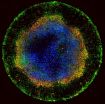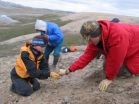(Press-News.org) Emotional and behavioral problems show up even with low exposure to lead, and as blood lead levels increase in children, so do the problems, according to research funded by the National Institute of Environmental Health Sciences (NIEHS), part of the National Institutes of Health. The results were published online June 30 in the journal JAMA Pediatrics.
"This research focused on lower blood lead levels than most other studies and adds more evidence that there is no safe lead level," explained NIEHS Health Scientist Administrator Kimberly Gray, Ph.D. "It is important to continue to study lead exposure in children around the world, and to fully understand short-term and long-term behavioral changes across developmental milestones. It is well-documented that lead exposure lowers the IQ of children."
Blood lead concentrations measured in more than 1,300 preschool children in China were associated with increased risk of behavioral and emotional problems, such as being anxious, depressed, or aggressive. The average blood lead level in the children was 6.4 micrograms per deciliter.
While many studies to date have examined health effects at or above 10 micrograms per deciliter, this study focused on lower levels. The CDC now uses a reference level of 5 micrograms per deciliter, to identify children with blood lead levels that are much higher than normal, and recommends educating parents on reducing sources of lead in their environment and continued monitoring of blood lead levels.
"Young children are particularly vulnerable to the toxic effects of lead, because lead can affect children's developing nerves and brains," said senior author Jianghong Liu, Ph.D., from the University of Pennsylvania School of Nursing, Philadelphia.
Lead is a naturally occurring toxic metal, but sources of lead exposure are often due to human activities, including burning fossil fuels, mining, and manufacturing. In the United States, lead exposure usually comes from lead-containing products, such as paint, caulking, and pipe solder, in older homes. In China, lead exposure is more often related to air pollution.
"The sources of lead exposure may explain why concentrations of lead are different," explained Liu. "In China, we found that blood lead concentrations increased with age in preschool children. In the United States, however, blood lead concentrations increase with age in children up to 2-3 years old and then decline."
For the study, the researchers analyzed one blood sample taken from each child between the ages of 3-5. Behavioral problems were assessed at age 6 using standardized questionnaires. The questionnaires were filled out by the children's teachers and parents, which the authors noted is both a strength and limitation. "The study used scores from two sources, but the ratings do not provide a clinical diagnostic measure of behavioral problems," said Liu.
U.S. studies have reported that lead exposure causes what psychologists call externalizing behavior problems, such as aggressiveness and bullying, which may lead to truancy and even jail time as children get older. In this study, children with higher blood lead levels had internalizing problems, such as anxiety and depression, as well as some externalizing problems. Though not addressed in this study, Liu said these differences could be explained by cultural, genetic, or environmental variations, or research gaps.
The authors emphasized, "Continuing monitoring of blood lead concentrations, as well as clinical assessments of mental behavior during regular pediatric visits, may be warranted."
INFORMATION:
NIEHS supports research to understand the effects of the environment on human health and is part of NIH. For more information on environmental health topics, visit http://www.niehs.nih.gov. Subscribe to one or more of the NIEHS news lists to stay current on NIEHS news, press releases, grant opportunities, training, events, and publications.
About the National Institutes of Health (NIH): NIH, the nation's medical research agency, includes 27 Institutes and Centers and is a component of the U.S. Department of Health and Human Services. NIH is the primary federal agency conducting and supporting basic, clinical, and translational medical research, and is investigating the causes, treatments, and cures for both common and rare diseases. For more information about NIH and its programs, visit http://www.nih.gov.
NIH...Turning Discovery Into Health®
Reference:
Liu J, Liu X, Wang W, McCauley L, Pinto-Martin J, Wang Y, Li L, Yan C, Rogan WJ. 2014. Blood lead levels and children's behavioral and emotional problems: a cohort study. JAMA Pediatr; doi:10.1001/jamapediatrics.2014.332.
Grant numbers:
R01ES018858
K01ES015877
K02ES019878
P30ES013508
Lead in kids' blood linked with behavioral and emotional problems
2014-06-30
ELSE PRESS RELEASES FROM THIS DATE:
Malaria parasite manipulates host's scent
2014-06-30
UNIVERSITY PARK, Pa. -- Malaria parasites alter the chemical odor signal of their hosts to attract mosquitos and better spread their offspring, according to researchers, who believe this scent change could be used as a diagnostic tool.
"Malaria-infected mice are more attractive to mosquitos than uninfected mice," said Mark Mescher, associate professor of entomology, Penn State. "They are the most attractive to these mosquito vectors when the disease is most transmissible."
Malaria in humans and animals is caused by parasites and can be spread only by an insect vector, ...
Adults can undo heart disease risk
2014-06-30
CHICAGO --- The heart is more forgiving than you may think -- especially to adults who try to take charge of their health, a new Northwestern Medicine® study has found.
When adults in their 30s and 40s decide to drop unhealthy habits that are harmful to their heart and embrace healthy lifestyle changes, they can control and potentially even reverse the natural progression of coronary artery disease, scientists found.
The study was published June 30 in the journal Circulation.
"It's not too late," said Bonnie Spring lead investigator of the study and a professor of ...
New Tel Aviv University research links Alzheimer's to brain hyperactivity
2014-06-30
Patients with Alzheimer's disease run a high risk of seizures. While the amyloid-beta protein involved in the development and progression of Alzheimer's seems the most likely cause for this neuronal hyperactivity, how and why this elevated activity takes place hasn't yet been explained – until now.
A new study by Tel Aviv University researchers, published in Cell Reports, pinpoints the precise molecular mechanism that may trigger an enhancement of neuronal activity in Alzheimer's patients, which subsequently damages memory and learning functions. The research team, led ...
Study helps unlock mystery of high-temp superconductors
2014-06-30
A Binghamton University physicist and his colleagues say they have unlocked one key mystery surrounding high-temperature superconductivity. Their research, published this week in the Proceedings of the National Academy of Sciences, found a remarkable phenomenon in copper-oxide (cuprate) high-temperature superconductors.
Michael Lawler, assistant professor of physics at Binghamton, is part of an international team of physicists with an ongoing interest in the mysterious pseudogap phase, the phase situated between insulating and superconducting phases in the cuprate phase ...
Tropical countries' growing wealth may aid conservation
2014-06-30
DURHAM, N.C. -- While inadequate funding has hampered international efforts to conserve biodiversity in tropical forests, a new Duke University-led study finds that people in a growing number of tropical countries may be willing to shoulder more of the costs on their own.
"In wealthier developing countries, there has been a significant increase in public demand for conservation, which has not yet been matched by an equivalent increase in protective actions by the governments of those countries," said Jeffrey R. Vincent, a Duke environmental economist who led the study, ...
Using geometry, researchers coax human embryonic stem cells to organize themselves
2014-06-30
About seven days after conception, something remarkable occurs in the clump of cells that will eventually become a new human being. They start to specialize. They take on characteristics that begin to hint at their ultimate fate as part of the skin, brain, muscle or any of the roughly 200 cell types that exist in people, and they start to form distinct layers.
Although scientists have studied this process in animals, and have tried to coax human embryonic stem cells into taking shape by flooding them with chemical signals, until now the process has not been successfully ...
Research team pursues techniques to improve elusive stem cell therapy
2014-06-30
Stem cell scientists had what first appeared to be an easy win for regenerative medicine when they discovered mesenchymal stem cells several decades ago. These cells, found in the bone marrow, can give rise to bone, fat, and muscle tissue, and have been used in hundreds of clinical trials for tissue repair. Unfortunately, the results of these trials have been underwhelming. One problem is that these stem cells don't stick around in the body long enough to benefit the patient.
But Harvard Stem Cell Institute (HSCI) scientists at Boston Children's Hospital aren't ready ...
Oil palm plantations threaten water quality, Stanford scientists say
2014-06-30
If you've gone grocery shopping lately, you've probably bought palm oil.
Found in thousands of products, from peanut butter and packaged bread to shampoo and shaving cream, palm oil is a booming multibillion-dollar industry. While it isn't always clearly labeled in supermarket staples, the unintended consequences of producing this ubiquitous ingredient have been widely publicized.
The clearing of tropical forests to plant oil palm trees releases massive amounts of carbon dioxide, a greenhouse gas fueling climate change. Converting diverse forest ecosystems to these ...
New study: Ancient Arctic sharks tolerated brackish water 50 million years ago
2014-06-30
Sharks were a tolerant bunch some 50 million years ago, cruising an Arctic Ocean that contained about the same percentage of freshwater as Louisiana's Lake Ponchatrain does today, says a new study involving the University of Colorado Boulder and the University of Chicago.
The study indicates the Eocene Arctic sand tiger shark, a member of the lamniform group of sharks that includes today's great white, thresher and mako sharks, was thriving in the brackish water of the western Arctic Ocean back then. In contrast, modern sand tiger sharks living today in the Atlantic Ocean ...
First pediatric autism study conducted entirely online
2014-06-30
UC San Francisco researchers have completed the first Internet-based clinical trial for children with autism, establishing it as a viable and cost effective method of conducting high-quality and rapid clinical trials in this population.
In their study, published in the June 2014 issue of the Journal of the American Academy of Child and Adolescent Psychiatry, the researchers looked at whether an Internet-based trial was a feasible way to evaluate whether omega-3 fatty acids helped reduce hyperactivity in children with autism. The authors found that not only was it a valuable ...



